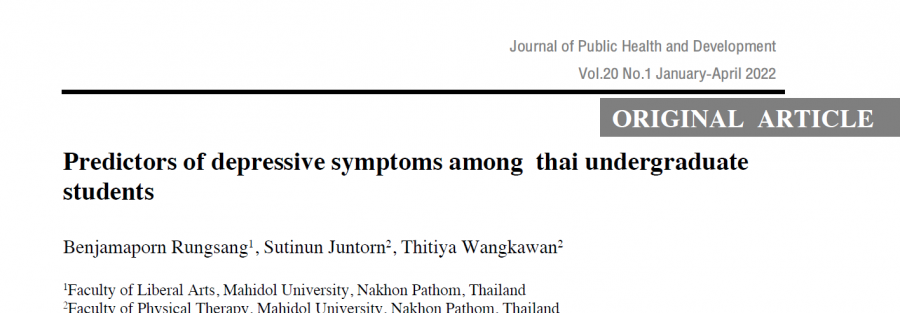Predictors of Depressive Symptoms among Thai Undergraduate Students
Journal /Conference
Journal of Public Health and Development
Authors
Rungsang, Benjamaporn(a); Juntorn, Sutinun(b); Wangkawan, Thitiya(b)
Affiliation
(a) Faculty of Liberal Arts, Mahidol University, Nakhon Pathom, Thailand
(b) Faculty of Physical Therapy, Mahidol University, Nakhon Pathom, Thailand
Abstract
Depression is a negative cognitive triad that consists of alternating amounts of alienation. In addition, this generally leads to inaction, remorse, lack of focus, societal disengagement, sleep disruptions, and suicidal impulses. The cross-sectional descriptive study intended to analyze depression and ascertain the influences of depression among 439 undergraduate students. These pupils were attending their second semester of the academic year 2020, Nakhon Pathom province, Thailand. Research instruments were self-report questionnaires, the 9-item patient health questionnaire, the Parenting Style Questionnaire, the Rosenberg’s Self-Esteem Scale, and the revised Multi-dimensional Scale of Perceived Social Support. The Cronbach’s alpha reliabilities comprised.85,.69,.72 and.92, respectively. Descriptive statistics and stepwise multiple regression analysis examined the data gathered. Results revealed that the mean score of depressive symptoms was 6.51 (SD = 4.27), which was minimal depressive symptoms. Authoritarian parenting style was the best significant predictor (β =.316), the second-best was social support (β =-.237), and the third-best was self-esteem (β =.104). The three predictors accounted for 20.7 % (F3, 435 = 37.837, p <.001) in the prediction of depressive symptoms among undergraduate students. Moreover, the findings recommended that healthcare providers and school workers should plan activities or interventions for undergraduate students. Consequently, they should encourage self-esteem, social support and cultivate appropriate parenting styles. As a result, depressive symptoms would decline. © 2022, Mahidol University – ASEAN Institute for Health Development. All rights reserved.
DOI / Link
10.55131/jphd/2022/200108

